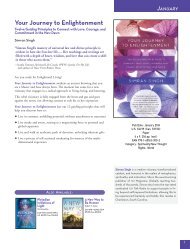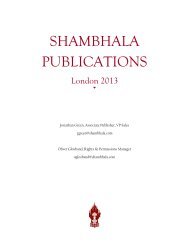Create successful ePaper yourself
Turn your PDF publications into a flip-book with our unique Google optimized e-Paper software.
EXCERPT FROM CHAPTER FIVE<br />
I think the time is now ripe to combine theoretical computer science with biology and to<br />
begin developing a theoretical mathematical biology.<br />
<strong>The</strong>se two technologies will converge. It is no accident that people talk about computer<br />
viruses and cyber-warfare and about developing an immune system to protect cyberassets.<br />
And what I am saying is that this isn’t just a metaphor. We can take advantage of<br />
this analogy to begin developing a mathematical theory of evolution.<br />
Darwin begins his book On the Origin of Species by taking advantage of the analogy<br />
between artificial selection by animal and plant breeders, the successful efforts of his<br />
wealthy neighbors to breed champion milk producing cows, racehorses and roses, and<br />
natural selection due to Malthusian limitations. I want to utilize the analogy between<br />
the random evolution of natural software, DNA, and the random evolution of artificial<br />
software, computer programs. I call this proposed new field “metabiology,” and it studies<br />
random walks in software space, hill-climbing random walks of increasing fitness.<br />
Random walks are an idea that mathematicians feel comfortable with. <strong>The</strong>re is a<br />
substantial literature on random walks. And I am just proposing a random walk in a richer<br />
space, the space of all possible programs in a given computer programming language,<br />
which is a space that is large enough to model biological creativity.<br />
I start with two observations. Firstly that DNA is presumably what computer scientists<br />
call a “universal programming language,” which means that it is sufficiently powerful to<br />
express any algorithm—in particular evo-devo teaches us to think of DNA as a computer<br />
program. Secondly, at the level of abstraction that I am working in my models, there is<br />
no essential difference between mathematical creativity and biological creativity, and<br />
so I can use mathematical problems for which there are no general methods in order to<br />
challenge my organisms and force them to keep evolving.<br />
Emil Post who is forgotten but whose work was at the level of that of Kurt Gödel and<br />
Alan Turing considered that the whole point of incompleteness and uncomputability was<br />
to show the essential role of creativity in mathematics. <strong>The</strong> emphasis on formal methods<br />
provoked by the computer temporarily obliterated Post’s insight, but metabiology picks<br />
up the torch of creativity again.<br />
To summarize, the general idea is that we are all random walks in program space! Our<br />
genomes are digital software that has been patched and modified for billions of years<br />
in order to deal with changes in the environment. In fact, I propose thinking of life as<br />
evolving software, and considering biology to be a kind of software archeology. Instead<br />
of La Mettrie’s L’Homme machine (1748), we now have L’Homme software.<br />
41






